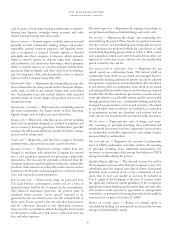American Express 2008 Annual Report Download - page 59
Download and view the complete annual report
Please find page 59 of the 2008 American Express annual report below. You can navigate through the pages in the report by either clicking on the pages listed below, or by using the keyword search tool below to find specific information within the annual report.2008 financial review
american express company
amount of undiscounted future payments disclosed in Note 15 to
the Company’s Consolidated Financial Statements. Historically,
even for an airline that is operating under bankruptcy protection,
this type of exposure usually does not generate any significant
losses for the Company because an airline operating under
bankruptcy protection needs to continue accepting credit and
charge cards and honoring requests for credits and refunds in the
ordinary course of its business. Typically, as an airline’s financial
situation deteriorates, the Company delays payment to the
airline thereby increasing cash withheld to protect the Company
in the event the airline is liquidated. The Company’s goal in
these distressed situations is to hold sufficient cash over time to
ensure that upon liquidation, the cash held is equivalent to the
credit exposure related to any unused tickets. The Company has
not to date experienced significant losses from airlines that have
ceased operations and entered into liquidation proceedings.
The current environment poses heightened challenges to the
Company’s ability to manage the airline risk, as more airlines
are converting their bankruptcy restructurings into liquidations
or, in some instances, moving directly to liquidation thereby
giving the Company less time to cover the Company’s exposure.
In addition, possible mergers, acquisitions and asset divestitures
in the airline industry may affect co-brand and Membership
Rewards relationships with involved airlines.
other reporting matters
accounting developments
See the Recently Issued Accounting Standards section of Note 1
to the Consolidated Financial Statements.
glossary of selected terminology
Adjusted average loans — Represents average loans on an owned
or managed basis, as applicable, excluding the impact of deferred
card fees, net of deferred direct acquisition costs of cardmember
loans on an owned or managed basis, as applicable.
Adjusted net interest income — Represents net interest income
allocated to the Company’s cardmember lending portfolio
on an owned or managed basis, as applicable, which excludes
the impact of card fees on loans and balance transfer fees
attributable to the Company’s cardmember lending portfolio
on an owned or managed basis, as applicable.
Asset securitizations — Asset securitization involves the transfer
and sale of receivables or loans to a special purpose entity
created for the securitization activity, typically a trust. The trust,
in turn, issues securities, commonly referred to as asset-backed
securities that are secured by the transferred receivables or loans.
The trust uses the proceeds from the sale of such securities to
pay the purchase price for the underlying receivables or loans.
Average discount rate — This calculation is designed to
approximate merchant pricing. It represents the percentage of
billed business (both proprietary and Global Network Services)
retained by the Company from merchants it acquires, prior to
payments to third parties unrelated to merchant acceptance.
Basic cards-in-force — Proprietary basic consumer cards-in-
force includes basic cards issued to the primary account owner
and does not include additional supplemental cards issued on
that account. Proprietary basic small business and corporate
cards-in-force include basic and supplemental cards issued to
employee cardmembers. Non-proprietary basic cards-in-force
includes all cards that are issued and outstanding under network
partnership agreements.
Billed business — Represents the dollar amount of charges on
all American Express cards; also referred to as spend or charge
volume. Proprietary billed business includes charges made
on the Company’s proprietary cards-in-force, cash advances
on proprietary cards and certain insurance fees charged on
proprietary cards. Non-proprietary billed business represents
the charges through the Company’s global network on cards
issued by the Company’s network partners. Billed business
is reflected in the United States or outside the United States
based on where the cardmember is domiciled.
Capital ratios — Represents the minimum standards established
by the regulatory agencies as a measure to determine whether
the regulated entity has sufficient capital to absorb on and off-
balance sheet losses beyond current loss accrual estimates.
Card acquisition — Primarily represents the issuance of new
cards to either new or existing cardmembers through marketing
and promotion efforts.
Cardmember — The individual holder of an issued American
Express branded charge or credit card.
Interest income — Interest and fees on loans is assessed using the
average daily balance method for loans owned. These amounts
are recognized based upon the principal amount outstanding in
accordance with the terms of the applicable account agreement
until the outstanding balance is paid or written-off.
Interest and dividends on investment securities primarily
relates to the Company’s performing fixed-income securities.
Interest income is accrued as earned using the effective
interest method, which adjusts the yield for security premiums
and discounts, fees and other payments, so that the related
investment security recognizes a constant rate of return on the
outstanding balance throughout its term. These amounts are
recognized until these securities are in default or when it is likely
that future interest payments will not be made as scheduled.
Interest income on deposits with banks and other is
recognized as earned, and primarily relates to the placement of
57
























